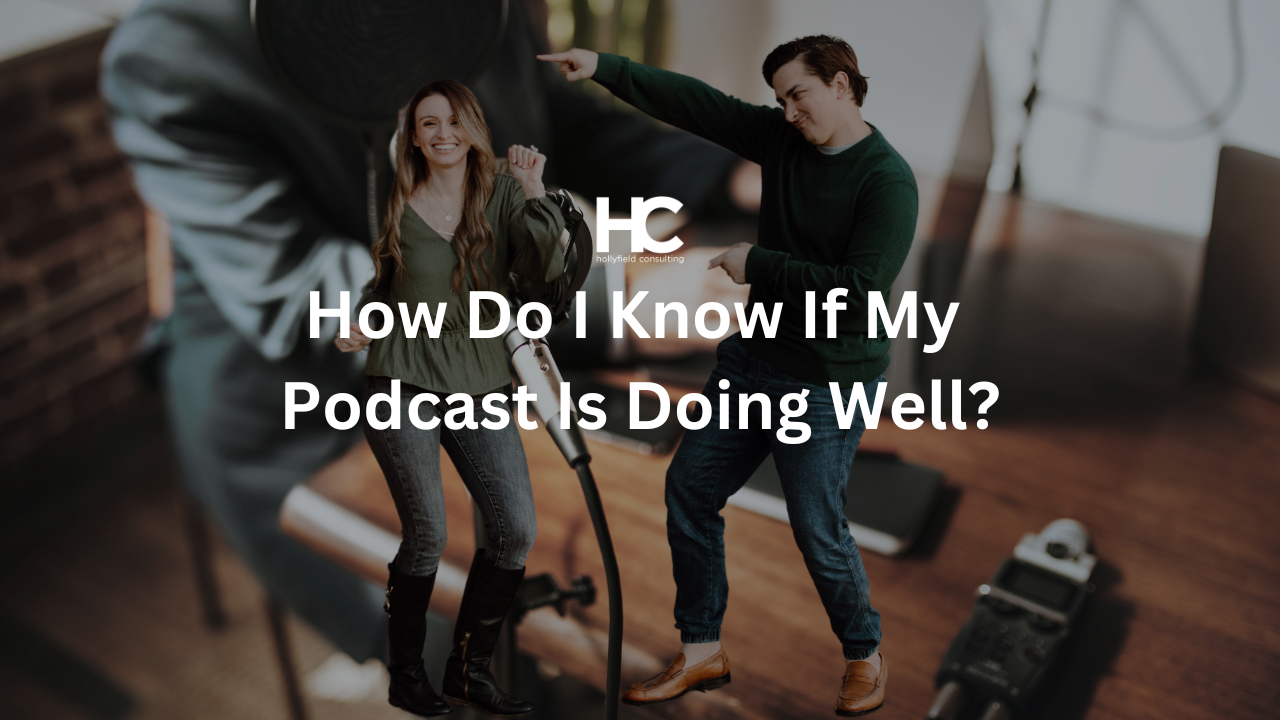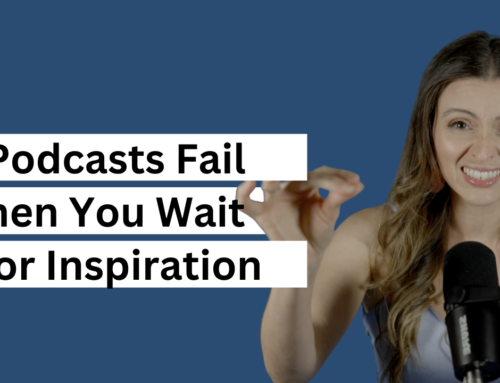Are you wondering how well your podcast is performing?
Great content is the right message for the right audience on the right platform at the right frequency! I know it’s a mouth full, but it’s the key to success.
On a basic level, you’ll know your content resonates with your audience when you start seeing download increase. When listeners like a podcast, they share it with others and on their social platforms. Over time, this leads to more subscribers and ultimately more downloads.
But, to really know if your podcast is succeeding, you’ll need to ask deeper questions. You’ll need to know where how the podcast functions in your sales funnel to measure the type of action you’re hoping podcast listeners take.
Podcasts can perform all types of functions within the sales funnel. They can generate awareness, nurture, and increase authority. For example, a brand might use a podcast to nurture a relationship with its target audience. Over time, they might see better-qualified leads and easier conversions for leads that come from the podcast. They wouldn’t only be looking at downloads to measure success. They’d be evaluating how they draw the right people to their podcast and how they get them to act.
Before you dive into the bigger picture, let’s get the basics out of the way. Below are all the details you’ll need to evaluate to get a base idea of your podcast’s performance.
How Does The Podcast Industry Measure Success?
Downloads are the key performance metric for the podcast industry. However, a download is not how long someone listens.
While every host would like to know how long someone listens, most hosting platforms like Libsyn or Buzzsprout report downloads. This is because listening apps like Apple, Spotify, and Google are all owned by separate companies and consider certain listener information proprietary. As a result, the agreed metric of success is downloads for the industry, and it is what those platforms report to hosting.
Now, while many hosting platforms allow you to automatically submit your RSS to certain listening apps, others like Libsyn require you to submit your RSS directly to Apple and Google through their podcast sites. That means you had to set up an Apple Podcast Connect account and log into Google Podcast Manager to submit your RSS. I’m telling you this because these platforms allow you to see data like how long someone listens to an episode and goes beyond downloads reported to hosting.
All that to say, if you want to know your total downloads, look in your hosting account. To go beyond downloads, you’ll have to look at the individual podcast platforms; most have a podcast manager site.
What Podcast Platforms Report Time Listening?
Apple Podcast Connect will allow you to see followers, listeners, duration, listens, engaged listeners, plays, and average consumption. You can also see trends! If you spend time evaluating an individual app’s performance, it should probably be Apple. Apple is the top way people listen to podcasts.
Google Podcast Manager will also let you see epsidoe data beyond downloads. Google will let you see plays, minutes played, new subscribers, plays in the first 30 days, and average duration played.
Spotify For Podcasters reports starts, streams, listeners, and follower data.
Where Does Your Podcast Land Against Industry Benchmarks?
For a basic idea of your podcast performance, weigh your downloads within the first seven days against the industry benchmark. This data is what advertisers want to know.
If your new episode gets, within seven days of its release:
- More than 26 downloads, you’re in the top 50% of podcasts.
- More than 72 downloads, you’re in the top 25% of podcasts.
- More than 231 downloads, you’re in the top 10% of podcasts.
- More than 539 downloads, you’re in the top 5% of podcasts.
- More than 3062 downloads, you’re in the top 1% of podcasts.
(podhost 2022 data)
While getting granular regarding your listening durations and followers is essential, downloads will be the overall industry measure of success.
What Do You Know About Your Ideal Podcast Listener?
The big question is, how do you know if you’re creating episodes people want to listen to and not wasting time or dollars? To do this, you have to think back to that formula I mentioned at the beginning – great content is the right message for the right audience on the right platform at the right frequency.
While the temptation is to start with your message or just start creating, the key to success is starting with your audience. Marketing strategy tells us to determine our target audience first, then nail down the solution you offer to their specific needs.
So, my question to you is not just, “What is your data saying?” but what do you know about your target audience (aka your ideal listener)? Who are you trying to attract, and are you creating episodes that will appeal to this person?
Getting a better idea of your ideal listener will inform the content you create and the interviews you book.
How Do You Produce Podcast Episodes?
There are lots of ways to produce new episodes, but if you want to do this strategically, you’ll want to create new episodes based on what your ideal listener is looking for.
We encourage hosts to make a long list of their ideal listener’s needs and create new episodes based on this list. You can even match guests to specific needs, so you know not only what direction to take an interview, but you’ll also know you’re booking the RIGHT guests.
Good content is deep content! That means that you create solo episodes and do interviews that break through the surface. Listeners are looking for more than an answer to a Google search. So, if you aren’t planning episodes, now is the time! Yes, allow the rhythm to flow in interviews or solo episodes, but also, get strategic to take those episodes deeper!
Good content is also vulnerable. An easy way to ensure you’re being authentically vulnerable is to think about the personal stories you can tell in solo episodes; you’ll also want to learn how to pull out good stories from your guests.
How Do You Write Your Episode Titles and Show Notes?
Episode titles and show notes can influence SEO. That means how you title your episodes and create your show notes can affect how your episode ranks on podcast apps and the web on search.
Follow simple SEO best practices to get the most out of your titles and show notes. Use appropriate keywords in your title and that exact keyword or phrase in the first sentence of your show notes.
How to take SEO further:
Podcast platforms can use simple show notes, but if you are adding your show notes to your website with a player for that episode, you might as well go full SEO!
Full SEO show notes should be between 1700-2000 words; this is likely much longer than what you want to appear on podcast apps. The goal of adding show notes on your website will be to help your entire site rank better for that keyword or phrase.
SEO show notes on your website are also an opportunity to create internal links and backlinks for your website. They can help you reach a larger marketing goal.
How Do You Promote Your Podcast?
Sharing new episodes on your social media and email lists is a great start. You can also promote your show by being a guest on other podcasts that share your ideal listener or using digital ads.
Like any other type of content creation, you need a marketing and promotion plan to get the word out! Simply publishing new episodes is rarely ever enough.
Social Media
Most people share their episodes on social media, but how you share new content makes a difference in capturing an audience. Always ensure your social media content passes the branding, message, and authenticity check. And remember, make it easy for the person to act!
Share content (photo or video) that encourages a relationship between you and your audience and ensure it’s branded or matches your brand aesthetic. Think of it this way; you’re more likely to get a response from a video showing a clip of the guest and host speaking versus a static image video with an audio wave. Likewise, photos of you or your guest plus verbiage that sounds personal will go further in creating relationships.
Another significant factor, next to authenticity, is the type of content the platform rewards! It can be nerve-wracking to try something new, but do this test – is this something my audience likes, and is it on brand? If the answer is yes, give it a go!
And if you’re considering trying a new platform because “everyone is,” make your decision based on whether or not the demographics of users on the platform match your ideal listener. You’re just chasing a shiny object if your audience isn’t there.
Do you have an email list? If your existing list matches your ideal listener, send out new episodes as part of your email drip. If your current list isn’t your target audience, consider building a new list.
Podcasts are great relationship builders; as such, they are an effective way to nurture your email list to the point of conversion – if the audiences match.
There are many ways to design an email – newsletters, personal letters, or a mix. First, consider your overall objective for the email list and where those people are at within your sales funnel to determine how to build out your email for success.
For lists that need to be nurtured by a thought leader, consider a personal letter with a single and straightforward call to action – listen to the podcast.
Keep in mind, that the more call-to-actions you have, the weaker your click-through rate is.
Interviews
A great way to build your audience and increase your brand reach is to be a guest on other podcasts. The key is to be a guest on a show that shares your ideal listener.
Create a dream list of shows sharing your ideal listener where your voice can reward their audience and start reaching out! We encourage you to have a landing page that shares your bio, speaking topics, podcast, and personality. This way, when your prospective show host scopes you out, you have great info to help them want to book you!
Digital Ads
If you are building your audience from scratch, digital ads are a great way to create traffic to your podcast website or landing page! In addition, you can influence downloads if your website or landing page is set up for conversion.
Do you have an existing brand and target audience who is (also) your ideal podcast listener? If so, you have an advantage! Existing brands with websites generating traffic can retarget website visitors on social platforms and encourage them to listen to the podcast.
Okay, y’all! Have I given you enough to see how your podcast is REALLY doing? Remember, success is bigger than your number of downloads. It’s only one part of the puzzle.
Zoom out and ask yourself, where is the podcast in my marketing funnel, and is it doing its job? Then, ask yourself how you can make it do better! The answer is always to generate deep content that resonates with your ideal listener and then make it easy for them to “act” and take the next step in your funnel.

10-Day Podcast Growth Challenge | Free Download
There is no secret sauce! Podcast growth is simple, but it’s not easy.
This ten-day challenge will ask you to drill down on your audience and the value you deliver. The truth is if you don’t have a clear message that solves a problem for a specific group of people, it won’t matter how much money you spend or how balls-to-the-wall you go with tactical promotion – your podcast won’t see long-term subscriber growth. This challenge best suits transformation podcasts trying to take someone from A to B.
Grow your podcast and yourself in this ten-day challenge.



